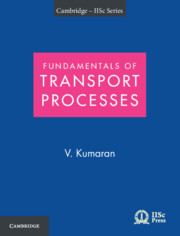Book contents
- Frontmatter
- Dedication
- Contents
- Preface
- 1 Introduction and Dimensional Analysis
- 2 Dimensionless Groups and Correlations
- 3 Diffusion and Dispersion
- 4 Unidirectional Transport: Cartesian Co-ordinates
- 5 Unidirectional Transport: Curvilinear Co-ordinates
- 6 Pressure-driven Flow
- 7 Conservation Equations
- 8 Diffusion Equation
- 9 Forced Convection
- 10 Natural Convection
- Bibliography
- Index
8 - Diffusion Equation
Published online by Cambridge University Press: 28 February 2025
- Frontmatter
- Dedication
- Contents
- Preface
- 1 Introduction and Dimensional Analysis
- 2 Dimensionless Groups and Correlations
- 3 Diffusion and Dispersion
- 4 Unidirectional Transport: Cartesian Co-ordinates
- 5 Unidirectional Transport: Curvilinear Co-ordinates
- 6 Pressure-driven Flow
- 7 Conservation Equations
- 8 Diffusion Equation
- 9 Forced Convection
- 10 Natural Convection
- Bibliography
- Index
Summary
Convection can be neglected when the Peclet number is small, and the field variables are determined by solving a Poisson equation ∇2Φ fv + S = 0 or a Laplace equation ∇2Φ fv = 0, subject to boundary conditions, where Φfv and S are the field variable and the rate of production per unit volume, respectively. It is necessary to specify two boundary conditions in each co-ordinate to solve these equations. The separation of variables procedure is the general procedure to solve these problems in domains where the boundaries are surfaces of constant co-ordinate. This procedure was earlier used in Chapters 4 and 5 for unsteady one-dimensional transport problems.
The procedure for solving the heat conduction equation in Cartesian co-ordinates is illustrated in Section 8.1. The ‘spherical harmonic’ solution for the Laplace equation in spherical co-ordinates is derived using separation of variables in Section 8.2, first for an axisymmetric problem of the heat conduction in a composite, and then for a general three-dimensional configuration. There are two types of solutions, the ‘growing harmonics’ that increase proportional to a positive power of r, and the ‘decaying harmonics’ that decrease as a negative power of r, where r is distance from the origin in the spherical co-ordinate system.
An alternate interpretation of the decaying harmonic solutions of the Laplace equation as superpositions of point sources and sinks of heat is discussed in Section 8.3. It is shown that the each term in the spherical harmonic expansions is equivalent to a term obtained by the superposition of sources and sinks in a ‘multipole expansion’. A physical interpretation of the growing harmonics is also provided.
The solution for a point source is extended to a distributed source in Section 8.4 by dividing the distributed source into a large number of point sources and taking the continuum limit. The Green's function procedure for a finite domain is illustrated by using image sources to satisfy the boundary conditions at planar surfaces.
Cartesian Co-ordinates
Consider the heat conduction in a rectangular block of length L and height H, in which the temperature is T0 at x = 0 and x = L, TA at y = 0 and TB at y = H, as shown in Fig. 8.1.
- Type
- Chapter
- Information
- Fundamentals of Transport Processes with Applications , pp. 373 - 420Publisher: Cambridge University PressPrint publication year: 2023

